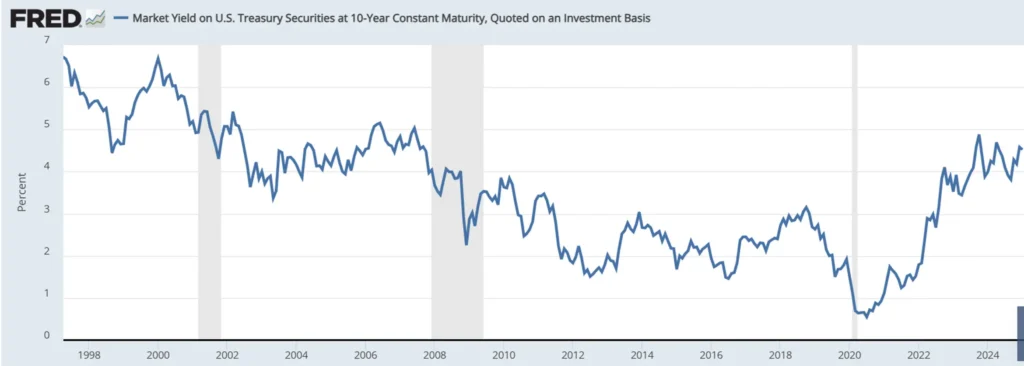Role Players
In Game 6 of the 1997 NBA Finals, Michael Jordan drove into the lane, pump-faked, and… passed it to Steve Kerr, a role player. Kerr sunk the shot and became the hero as the Chicago Bulls went on to win the NBA championship.
No one anticipated that Kerr would be the one to take the final shot; everyone assumed it would be Michael Jordan. However, Kerr delivered when his team needed it the most. Although he wasn’t highlighted as a key reason for the Bulls’ earlier success, this clutch moment has cemented his place in basketball history.
Boring Bonds
When constructing an investment portfolio, certain asset classes stand out and entice investors, such as crypto, tech stocks, or equities in general. Bonds, often called “fixed income,” typically don’t generate the same level of excitement.
Eyesore
To make matters worse, over the last five years (2/1/20 through 1/31/25), bonds (as measured by the iShares Core US Aggregate Bond ETF) have returned -0.6% annualized. Meanwhile, they had a drawdown in 2022 of -17.1%.
Contrast that to stocks (as measured by the S&P 500), which have produced an annualized return of 15.1% over the last five years.
The question becomes, “Why would anyone in their right mind own bonds?” Over the last five years, bonds have not only underperformed, but they’ve done it with significant volatility and a high correlation to stocks.
The Landscape
A bit of context may help (the graph below is critical to understanding bonds).

Source: Federal Reserve Economic Data, February 6, 2025
At the turn of the century 25 years ago, 10-year U.S. Treasury yields were 6.45%. You could loan the US Treasury money for 10 years, get paid 6.45% annually, and return your principal at the end of the 10 years.
By July 2020, these same yields were down to 0.55%.
Over the course of the last twelve months, these yields have zigged and zagged around 4.5%.
Interest Rates and Bond Prices
When purchasing a bond, many investors assume the price is fixed, expecting to receive their initial investment back along with interest. While you do get back what you invested (provided the issuing company or municipality remains solvent), the bond’s price can fluctuate over time.
For example, if you buy a bond with a fixed interest rate of 0.55% for ten years, and market conditions change so that new bonds are issued with a 5% interest rate, your bond paying 0.55% becomes much less valuable, causing its price to drop. All else being equal, rising interest rates lead to falling bond prices, while falling interest rates lead to rising bond prices.
For 20 years (2000 – 2020, see again the chart above), falling interest rates provided a massive tailwind for bond prices, and most bond investors were quite happy.
However, since 2020, two things have combined in the bond world, creating an ugly combination…
- Starting interest rates were next to nothing (0.55%). There was essentially no “yield cushion” for bond investors, and
- A sudden increase in interest rates created a forceful headwind on bond prices. In fact, bond yields have seen the largest four-year yield gain since 1981, when inflation was 10.3%.
With current 10-year interest rates around 4.5%, we now have a “yield cushion” that was not present for much of the last 10 years. Even if the price of your bond decreases, it is still possible that the current income offsets the price decline.
A Tale of Two Bonds – Boring Bonds and Credit
When someone declares, “I hold 40% of my portfolio in bonds”, it doesn’t tell you much because various types of bonds behave quite differently.
Between January 2020 and April 2020, the Vanguard Extended Duration Treasury (ticker EDV) returned 29.0%, while the SPDR Portfolio High Yield Bond ETF (ticker SPHY) returned -13.6%. Meanwhile, the iShares Core US Aggregate Bond ETF (ticker AGG, and what most investors refer to as the “bond index”) was up 3.1% in those three months.
Source: Portfoliovisualizer.com
This is the very reason The Bahnsen Group bifurcates bonds into Boring Bonds (interest rate risk but very little credit/default risk) and Credit (credit/default risk but not as much interest rate risk). For more on the way we construct portfolios, see David Bahnsen’s Dividend Cafe Magnifying Old and New Lessons.
So, Should I Own Bonds?
The answer to this question is the all-satisfying answer of “it depends.”
Over a long period of time, an investor would expect asset classes like stocks, real estate, and most alternatives to outperform bonds. For some investors seeking to build wealth, bonds may not be necessary at all.
However, a few reasons one may choose to own bonds include:
- Diversification – historically, high-quality bonds have performed well during “risk-off” events as investors flee to safety.
- Stability and Capital Preservation – although 2022 was an exception, bonds tend to be quite stable as compared to stocks.
- Income – most bonds now pay a substantially higher income stream than stocks.
- Dry powder – some investors use bonds as an opportunity fund for adding to the market during a downturn, purchasing a business, etc.
- Safety net – A mathematical safety net if you are withdrawing from your portfolio and a psychological buffer when the stock market is volatile.
- Potential Capital appreciation – Now that we finally have a “yield cushion” of ~4.5%, a severe economic downturn would likely lead to a decrease in interest rates, providing a tailwind for bonds. However, the opposite can also happen.
- Tax advantages – if owning municipal bonds, the interest may be federally tax-free (and potentially state-tax-free)
Bonds should rarely be the largest piece of an investor’s portfolio, but for many investors, they can be looked at as role players.
The greatest takeaway I will leave you with is this… if you are abandoning bonds just because they have been a poor performer for the last five years, reconsider the role bonds are supposed to play in your portfolio.
As always, please reach out to your Private Wealth Advisor to discuss more. We love hearing your questions, and we are here for you.
Blaine Carver
Private Wealth Advisor
Trevor Cummings
PWA Group Director, Partner







